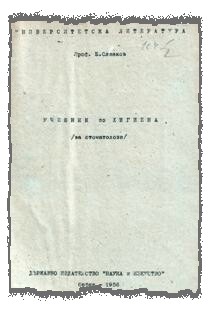
HYGIENE ~ TEXTBOOK FOR STUDENTS
Author: Boris Slavkov

What is the state of affairs with hygiene, as a major prophylactic science in Bulgaria? Here are some preliminary notes on the development of the discipline in this country. A major report is subject matter of a more detailed research and will be included in the context for history of medicine in Bulgaria, per se.
Early efforts for organized hygiene science are associated with the name of a prolific medical functionary - namely, Prof. Toshko Petrov /1872-1942/. The evolution of hygiene as such and is a long process during ages of progressive changes and renovations. On the genesis of prophylaxis in ancient times and in the middle ages, we intend to write a separate article. Documentation is scarce and evidence is based mainly on sources from foreign observers.
After liberation from Turkish dominion in 1878 and establishment of independent Bulgarian state, subsequently, science and history are based on solid scientific basis in that country. But efforts to generate some consistent prophylactic activity are still in their beginning and this is until end of First World War. While a Medical Faculty was established officially in year 1918 and a Department of Hygiene was one of its constituent branches. It was headed by a full time professor T. Petrov.
The carrier of this medical doctor until his academic promotion is versatile. We shall try to give some features from his life and works, while, an expansion of bio-bibliography is expected to be researched later. He was born in city of Lovech and got his early education there. Graduated medicine in Geneva and Lyon /1897/. Has specialized in hygiene and preventive medicine from Toulouse and Paris /1905-1907/. Appointed to work as a sanitary physician in Teteven, Russe and Botevgrad (i.e., old time Orchane - namely, here is where his first sanitary description of the Orchane district was written as a report to the Directorate of Public Health. And for the sake of argument let us note that this report was not a first of its kind, since it was preceded some 10 /ten/ years earlier by another written evidence from a Lithuanian physician on bulgarian service - viz., in our booklist "Basanovich, I. Materials on Sanitary Ethnography of Lom District /vol. V from SNUNK/. Sofia: Durjavna Pechatnitza, 1891, 186 pp.").
From 1919 to 1942, Prof. T. Petrof is with the Department of Hygiene, Medical Faculty - Sofia. The story of this interwar years is long and cumbersome to narrate. T. Petrov's activities are reflected in more than 85 publications during his lifetime. He was Dean of Medical Faculty from 1920 to 1925. He was associate /1925/ and full member /1929/ of the Bulgarian Academy of Science (BAS). He was a founding member and chairman of the BDHPM /i.e., Bulgarian Association of Hygiene and Preventive medicine - transliteration is from bulgarian/ and editor-in-chief to Revue Bulgare d'Hygiene ~ Bulgarian Hygiene Review from 1931-1942. And he had many international recognitions, among other things in Paris, Rome and Berlin. Prof. T. Petrov died during the war in 1942.
I shall stop my narrative here and proceed with few words on the textbook from Prof. Boris Slavkov. He was one of the early students of T. Petrov and in a sense this book is a continuation of the major opus of the latter on Hygiene /see, booklist under title T. Petrov/. It brings the state of affairs on prophylactic disciplines until the early 1950s, when, major processes of differentiation and integration split hygiene into constituent sciences - such as, Health Care Organization /or Social Hygiene/, Epidemiology /with Infectious Diseases/, General Hygiene /on sanitary grounds/, etc.
Picture 1: This is the present building of the Centre of Hygiene, which is being renamed National Center for Health Protection.
|
(i). The contemporary Department of Hygiene is situated within the structure of the Medical Faculty. Much debated question has been the whereabouts of the department before transferring to this modern building /i.e., build and designed for the purposes of the newly established Medical Academy in mid-1970s/. We have established a former location of the Department of Hygiene on "Dunav" Street, specifically on the back of the present day Faculty of Pharmacy. This building has lodged formerly "High School Gymnasium" № 1 and has undergone heavy renovation. As further projection of these considerations and the author wonders, whether it could be possible to set up a museum on the premises where bulgarian hygiene was born. |
Copyright © 2005 by the author.